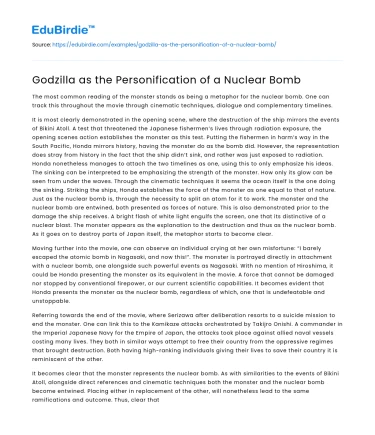The most common reading of the monster stands as being a metaphor for the nuclear bomb. One can track this throughout the movie through cinematic techniques, dialogue and complementary timelines.
It is most clearly demonstrated in the opening scene, where the destruction of the ship mirrors the events of Bikini Atoll. A test that threatened the Japanese fishermen’s lives through radiation exposure, the opening scenes action establishes the monster as this test. Putting the fishermen in harm’s way in the South Pacific, Honda mirrors history, having the monster do as the bomb did. However, the representation does stray from history in the fact that the ship didn’t sink, and rather was just exposed to radiation. Honda nonetheless manages to attach the two timelines as one, using this to only emphasize his ideas. The sinking can be interpreted to be emphasizing the strength of the monster. How only its glow can be seen from under the waves. Through the cinematic techniques it seems the ocean itself is the one doing the sinking. Striking the ships, Honda establishes the force of the monster as one equal to that of nature. Just as the nuclear bomb is, through the necessity to split an atom for it to work. The monster and the nuclear bomb are entwined, both presented as forces of nature. This is also demonstrated prior to the damage the ship receives. A bright flash of white light engulfs the screen, one that its distinctive of a nuclear blast. The monster appears as the explanation to the destruction and thus as the nuclear bomb. As it goes on to destroy parts of Japan itself, the metaphor starts to become clear.
Save your time!
We can take care of your essay
- Proper editing and formatting
- Free revision, title page, and bibliography
- Flexible prices and money-back guarantee
Moving further into the movie, one can observe an individual crying at her own misfortune: “I barely escaped the atomic bomb in Nagasaki, and now this!”. The monster is portrayed directly in attachment with a nuclear bomb, one alongside such powerful events as Nagasaki. With no mention of Hiroshima, it could be Honda presenting the monster as its equivalent in the movie. A force that cannot be damaged nor stopped by conventional firepower, or our current scientific capabilities. It becomes evident that Honda presents the monster as the nuclear bomb, regardless of which, one that is undefeatable and unstoppable.
Referring towards the end of the movie, where Serizawa after deliberation resorts to a suicide mission to end the monster. One can link this to the Kamikaze attacks orchestrated by Takijro Onishi. A commander in the Imperial Japanese Navy for the Empire of Japan, the attacks took place against allied naval vessels costing many lives. They both in similar ways attempt to free their country from the oppressive regimes that brought destruction. Both having high-ranking individuals giving their lives to save their country it is reminiscent of the other.
It becomes clear that the monster represents the nuclear bomb. As with similarities to the events of Bikini Atoll, alongside direct references and cinematic techniques both the monster and the nuclear bomb become entwined. Placing either in replacement of the other, will nonetheless lead to the same ramifications and outcome. Thus, clear that the monster represents the nuclear bomb.






 Stuck on your essay?
Stuck on your essay?

